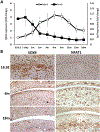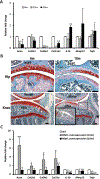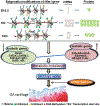Epigenetic Mechanisms Underlying the Aging of Articular Cartilage and Osteoarthritis
- PMID: 30970348
- PMCID: PMC9150844
- DOI: 10.1159/000496688
Epigenetic Mechanisms Underlying the Aging of Articular Cartilage and Osteoarthritis
Abstract
Aging is a progressive and complicated bioprocess with overall decline in physiological function. Osteoarthritis (OA) is the most common joint disease in middle-aged and older populations. Since the prevalence of OA increases with age and breakdown of articular cartilage is its major hallmark, OA has long been thought of as "wear and tear" of joint cartilage. Nevertheless, recent studies have revealed that changes in the chondrocyte function and matrix components may reduce the material properties of articular cartilage and predispose the joint to OA. The aberrant gene expression in aging articular cartilage that is regulated by various epigenetic mechanisms plays an important role in age-related OA pathogenesis. This review begins with an introduction to the current understanding of epigenetic mechanisms, followed by mechanistic studies on the aging of joint tissues, epigenetic regulation of age-dependent gene expression in articular cartilage, and the significance of epigenetic mechanisms in OA pathogenesis. Our recent findings on age-dependent expression of 2 transcription factors, nuclear factor of activated T cell 1 (NFAT1) and SOX9, and their roles in the formation and aging of articular cartilage are summarized in the review. Chondrocyte dysfunction in aged mice, which is mediated by epigenetically regulated spontaneous reduction of NFAT1 expression in articular cartilage, is highlighted as an important advance in epigenetics and cartilage aging. Potential therapeutic strategies for age-related cartilage degeneration and OA using epigenetic molecular tools are discussed at the end.
Keywords: Aging; Articular cartilage; Epigenetics; Gene expression; Nuclear factor of activated T cell 1; Osteoarthritis.
© 2019 S. Karger AG, Basel.
Conflict of interest statement
Conflicts of interest
The authors declare no conflicts of interest.
Figures



Similar articles
-
Nfat1 regulates adult articular chondrocyte function through its age-dependent expression mediated by epigenetic histone methylation.J Bone Miner Res. 2011 Aug;26(8):1974-86. doi: 10.1002/jbmr.397. J Bone Miner Res. 2011. PMID: 21452283 Free PMC article.
-
Epigenetic mechanisms underlying the aberrant catabolic and anabolic activities of osteoarthritic chondrocytes.Int J Biochem Cell Biol. 2015 Oct;67:101-9. doi: 10.1016/j.biocel.2015.04.019. Epub 2015 May 12. Int J Biochem Cell Biol. 2015. PMID: 25975825 Free PMC article. Review.
-
Transcription factor Nfat1 deficiency causes osteoarthritis through dysfunction of adult articular chondrocytes.J Pathol. 2009 Oct;219(2):163-72. doi: 10.1002/path.2578. J Pathol. 2009. PMID: 19526482 Free PMC article.
-
Chaperonin 60 regulation of SOX9 ubiquitination mitigates the development of knee osteoarthritis.J Mol Med (Berl). 2016 Jul;94(7):755-69. doi: 10.1007/s00109-016-1422-3. Epub 2016 Apr 27. J Mol Med (Berl). 2016. PMID: 27118120
-
Molecular regulation of articular chondrocyte function and its significance in osteoarthritis.Histol Histopathol. 2011 Mar;26(3):377-94. doi: 10.14670/HH-26.377. Histol Histopathol. 2011. PMID: 21210351 Review.
Cited by
-
Enrichment of genomic pathways based on differential DNA methylation profiles associated with knee osteoarthritis pain.Neurobiol Pain. 2022 Nov 3;12:100107. doi: 10.1016/j.ynpai.2022.100107. eCollection 2022 Aug-Dec. Neurobiol Pain. 2022. PMID: 36531611 Free PMC article.
-
Mouse microRNA signatures in joint ageing and post-traumatic osteoarthritis.Osteoarthr Cartil Open. 2021 Dec;3(4):100186. doi: 10.1016/j.ocarto.2021.100186. Osteoarthr Cartil Open. 2021. PMID: 34977596 Free PMC article.
-
Downregulation of HAS‑2 regulates the chondrocyte cytoskeleton and induces cartilage degeneration by activating the RhoA/ROCK signaling pathway.Int J Mol Med. 2023 Jul;52(1):57. doi: 10.3892/ijmm.2023.5260. Epub 2023 May 26. Int J Mol Med. 2023. PMID: 37232339 Free PMC article.
-
Acetabular cartilage abnormalities in elderly patients with femoral neck fractures.SICOT J. 2022;8:24. doi: 10.1051/sicotj/2022022. Epub 2022 Jun 14. SICOT J. 2022. PMID: 35699460 Free PMC article.
-
The Effects of Age and Cell Isolation on Collagen II Synthesis by Articular Chondrocytes: Evidence for Transcriptional and Posttranscriptional Regulation.Biomed Res Int. 2020 Apr 30;2020:4060135. doi: 10.1155/2020/4060135. eCollection 2020. Biomed Res Int. 2020. PMID: 32461985 Free PMC article.
References
-
- Bird A: DNA methylation patterns and epigenetic memory. Genes & development 2002;16:6–21. - PubMed
Publication types
MeSH terms
Substances
Grants and funding
LinkOut - more resources
Full Text Sources
Medical
Research Materials

